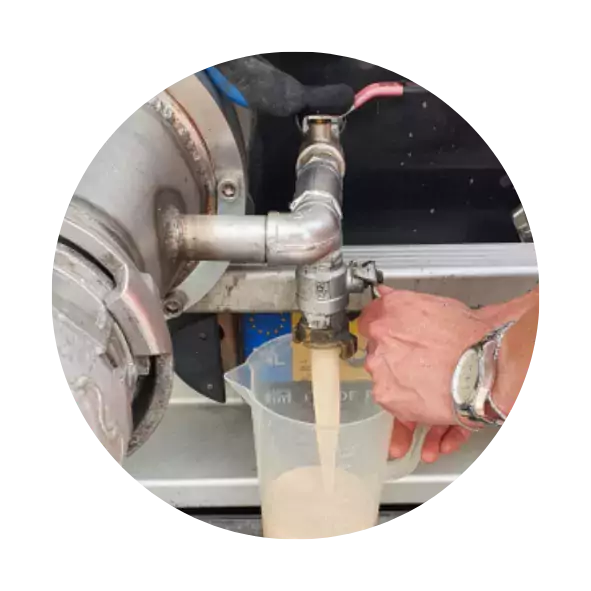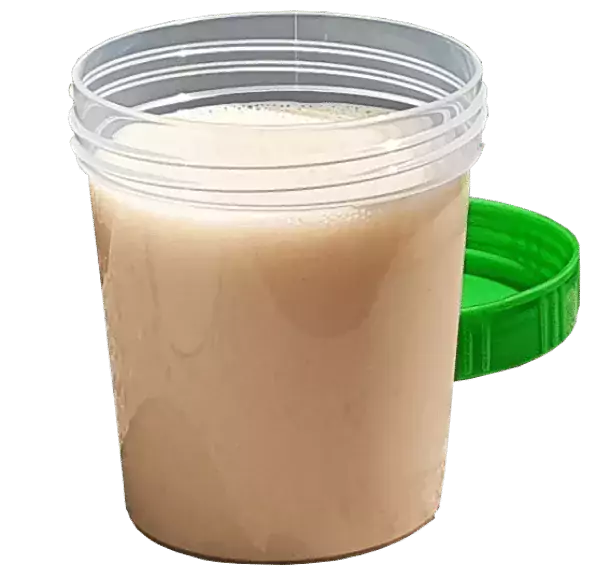Dry matter policy
At Looop, we believe it is important to communicate openly and honestly about our dry matter policy.
We would like to tell you all about this.
Looopsymbol
Quality and sampling
Proper sampling is necessary for monitoring and traceability, and for a correct calculation (based on dry matter) of the feed.
The sample must be representative of the entire load. It is important to comply with the guidelines described in the GMP+BA13 protocols.
Curious about how we sample?


Three equal-sized subsamples are taken from the sample valve.
These samples are taken during the loading or unloading of the first five tons, when the cargo is half loaded or unloaded, and at the last five tons. We do this with every cargo. The three samples are combined and mixed in a measuring cup. This results in a reliable mixed cargo sample. Four final samples are then created from this; one for the supplier, one for the customer, and two for Looop.
In order to guarantee the right quality level, Looop receives two samples of each cargo:
1. The storage sample which is kept refrigerated and sealed for three months.
2. The sample for analysis, from which the dry matter is determined.
Each sample is labelled with the unique information of the respective cargo and linked to our processes. As a result, all cargoes can be traced on the basis of the sample.
In addition and according to the rules of GMP+ and Securefeed, a sample is taken from each product for analysis at an independent laboratory for the microbial and nutritional wet-chemical analysis at least four times a year.
Would you like to know what method we use to determine dry matter?

Dry matter procedure Looop
Dry matter as a starting point for invoicing
The dry matter percentage is the basis for invoicing the product. This content is determined by Looop or the supplier. The dry matter percentage is measured in our laboratory using three different techniques:
1. Halogen fast drying
2. Traditional drying oven
3. Nearby Infrared Radiation (including nutrient value assessment)

The standard: NIR Spectrometer
The NIR Spectrometer has been used at Looop for determining dry matter since the end of 2021. In addition to determining the dry matter percentage, this technique has a great additional advantage: the NIR also calculates nutrient values such as protein, starch and sugars in the product. This technique is suitable for the product groups: wheat starch, wheat yeast concentrate, beer yeast and potato steam peels.

The Drying Kiln - Alternative
The dry matter percentage of some co-products cannot be measured using the NIR. For those byproducts, a drying kiln is used. The sample is weighed in a traditional drying kiln and placed in a temperature of 103°C. The sample is then weighed again and the dry matter percentage calculated. This procedure is in accordance with NEN-ISO 6496.
The customer will receive one sample with each shipment. If this sample is used quickly or kept refrigerated until the measuring, it is a suitable sample for the dry matter remeasuring on the farm. The sample is representative of the delivered product and will be transported and delivered in a refrigerated environment.

Dry matter remeasuring
To determine the percentage of dry matter correctly, there are a number of conditions that must be observed.
- Homogeneity of the product: It is important that the content of the sample to be used is homogeneous. Especially with products that sag, it is advisable to stir the sample well before measuring.
- Time of sampling: The sample supplied should be used immediately or within 48 hours of refrigerated storage.
- Hygiene: Always use clean material.
- Dry matter meter: We recommend a temperature of 103°C for drying. Make sure the dry matter meter is clean, dry and straight. To ensure that no major deviations occur, it is important to calibrate the meter annually.
- Store in a cool place: We recommend always keeping the sample refrigerated until at least invoicing. If a difference in dry matter is found, store the sample - refrigerated of course - for at least two weeks after submitting the dry matter difference.
The terms and conditions at a glance:
- The complaint must be submitted within three working days of the invoice date in order to be processed.
- In the case of a dry matter determination by the customer, only the sample delivered with the load may be considered as a representative sample (for this load). Self-samples are not accepted.
- We apply a tolerance of 1.5%* absolute difference in dry matter as described in the animal feed legislation (Regulation (EC) No. 767/2009). This means that a difference <1.5% will not be considered.
- If after re-analysis of a moisture-rich co-product the dry matter content differs more than 1.5%, we shall reimburse the difference in dry matter after deduction of 1.5% tolerance.
- Only complaints submitted through complaints@looop.company will be processed.
Wondering how to file a correct and complete complaint?

How to submit dry matter differences
If a difference in dry matter is found, please report it to complaints@looop.company.
It is important to indicate this as soon as possible, at the latest three working days after the invoice date. Please include (1) company name, (2) telephone number, (3) cost centre number, (4) delivery date, (5) product name, (6) DM% measured by Looop, (7) own measured DM% and (8) invoice number. Please substantiate your own measured dm by sending a picture of the measured value.
We aim to respond within three working days.

*Fermentation process
This 1.5% is based on the fermentation process. Products such as ground potato steam peels, liquid wheat starch and wheat yeast concentrate have a high carbohydrate content. Carbohydrate-rich products may ferment during the storage period, as the environmental conditions in the storage tanks are often favourable for this (warm, prolonged storage).
The products formed during the fermentation process have a beneficial effect on animal performance. Most by-products contain nutrients that are fermentable, such as sugars, and have a low pH (between 3.5 and 4). During fermentation, sugars are converted by lactic acid bacteria into alcohol and organic acids such as lactic acid (energetically equivalent to starch). Lactic acid not only has a positive effect on the tastiness of the product, it also promotes intestinal health. Lactic acid bacteria fall into the category of healthy intestinal bacteria and act as probiotics.
Organic acids contribute to the nutritional value of the product, but when reanalysed to determine the dry matter, they partly evaporate during the drying process. This evaporation does not take place when the product is in storage. Therefore, we apply a tolerance of 1.5%.

